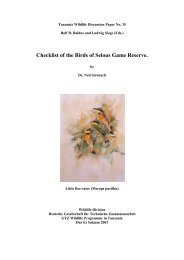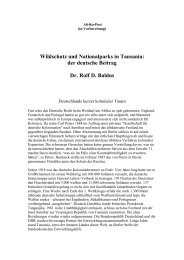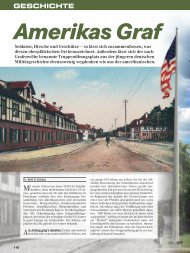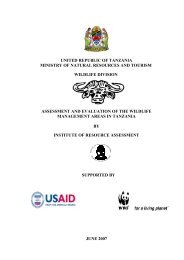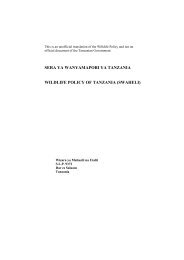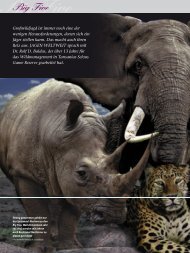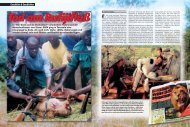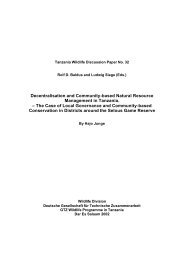Common opinion has it that hunting is forbidden in national parks, yet the truth is that 59 out of 390properties administered by the National Parks Service (NPS) allow sportsmen to manage <strong>wildlife</strong>. In total35% of the NPS acreage is open to sportsmen (29,943,312 acres of which 19,677,033 are in Alaska).The hunting regulations are buried in thousands of pages of US Code. In Title 36, Volume 1 of the Codeof Federal Regulations, we find this phrase: “Hunting shall be allowed in park areas where such activity isspecifically mandated by Federal statutory law”.A NPS spokesperson said that there are three regulatory reasons why sportsmen may or may not bewel<strong>com</strong>e in a national park:1. A park’s original legislation can forbid or mandate hunting (regulated by the US Congress)2. A park’s superintendent’s <strong>com</strong>pendium can regulate some practices, such as hunting(superintendents make some rules)3. Local regulations may further restrict activities (state seasons can affect park rules)The real astonishing fact behind the “reason”, why some parks don’t allow hunting, is that Congress nevertold them to allow it! Consequently the NPS decided that such parks are closed to hunting.Chris W Cox, a NRA-ILA Executive Director says that “the regulations are backwards – hunting should beallowed unless Congress or the administration must close it for safety or security reasons, not the other wayround.”The present debate whether to hunt or not to hunt in national parks has however a simple reason – manyparks don’t know what to do about burgeoning <strong>wildlife</strong> populations!In North Dakota’s 70,448 acre Theodore Roosevelt National Park (TRNP) the 750 head strong elk herd isabout twice the optimal number for the habitat. In the past elk were live-caught and transported to otherparks, but with prevalent Chronic Wasting Disease (CWD) this solution had to be scrapped. The park’ssuperintendent stated that elk hunting outside the [unfenced] park’s borders is ineffective, since 75% of theherd stays permanently inside the park. NPS was considering hiring sharpshooters, rounding up the animalsin pens and killing them.Why not hunt the elk? The superintendent said that “hunting in a park would set a precedent”! Thelegislation that set up TRNP does not specifically say that hunting must be allowed or prohibited.Another example – Yellowstone National Park and its elk herd. The herd size there has shrunk to 9,500animals (about half the size from the mid 1990s. The average age of elk increases – in 2005 cows reached8.2 years and bulls 9.1 years versus ten years ago, when the average age was 6.2 and 5.9 years. Theaverage ages of elk in [hunted] areas are generally in the range of 4 to 5 years. The Yellowstone herd isbe<strong>com</strong>ing geriatric because of low calf survival rate inside the park (70 to 75% succumb in the first year), andthis is caused by high predation pressure from bear and wolf. If hunting predators in Yellowstone wereallowed, the calf survival rate would rise.One more example: The Hanford Reach National Monument in Washington State was gazetted in 2000and hunting ceased – since then the elk population exploded to more than double the carrying capacity.Since 2000, the State has paid more than US$ 500,000 in crop damages caused by elk. Now a managementplan which includes hunting is being considered.The logical way out would be regulated hunting in national parks – this <strong>wildlife</strong> management approach isalso economically viable [and would reward sportsmen] who anyhow sent US$ 294.691,282 to stateconservation programs in 2005 through the surtaxes paid on guns, ammunition and other items.118
The Influence of Trophy Measurement in Cape BuffaloBy Winston Taylor, Environmental Biology, Oxford Brookes UniversityEditor’s Note: Winston Taylor’s scientific paper (Full Title: The Influence of Trophy Measurement on the Ageof Sport Hunted Buffalo, Syncerus Caffer (Sparrman), in the Zambezi Valley, Zimbabwe, and its Implicationsfor Sustainable Trophy Hunting,2005) has been adapted to the format of <strong>African</strong> <strong>Indaba</strong>. Due to time constraints the author could not beconsulted prior to publication, hence errors and omissions are the editor’s fault. You can download theoriginal paper from www.africanindaba.co.zaConserving <strong>wildlife</strong> in Africa is often difficult as it conflicts with humans and their activities. “One way tomake conservation gains”, particularly in the <strong>African</strong> context, “is to capitalize on the importance of wildspecies in human livelihoods”. The “sustainable harvesting of plants and hunting of animals has often turnedout to be a highly effective conservation measure” (Hutton, 2004). Sport hunting has a long and involvedhistory in Africa. The appeal of the classic “<strong>African</strong> Safari” was stimulated by the likes of Ruark andHemingway in their numerous tales of hunting and adventure in the wilds of Africa.Hunting is an important tool in conservation although it must not be seen as conservation in itself.Commercial hunting is of great value in both the economic and ecological sense. Low off-takes of trophyanimals provide good financial returns with minimal investment. Sport hunting is also a major force behindthe preservation of <strong>wildlife</strong> and wild places.The growing fragmentation of species’ habitats over the last century has led to the emergence of<strong>com</strong>munity based conservation whereby local <strong>com</strong>munities are encouraged to value <strong>wildlife</strong> through bothnon-consumptive and consumptive activities (e.g. hunting) from which they receive multiple benefits. Prior tothese new “radical” ways of tackling conservation, much of colonial Africa was subject to state-centric“fortress conservation”, in which rural <strong>African</strong>s were seen as the enemy of conservation and degraders of theenvironment. Community conservation on the other hand encourages, through the concept of “sustainabledevelopment”, that species, habitats and biodiversity, should be seen as exploitable and managed throughconservation and developmental goals.Villagers are given a share in license fees paid by wealthy clients and suddenly see a species, such asbuffalo or elephant, not as a menacing crop raider but as a highly valuable asset which should be protected.Clients will also be charged a range of fees by the government, collected either directly or on thegovernment’s behalf by the safari operator. Such fees are likely to include a conservation fee, firearms andammunition permit fees, trophy export fees, airport fees etc. It is through such systems that hunting can beused as a tool in conservation. However, if hunting is to be pursued in areas where <strong>wildlife</strong> resources arefinite, a tight management regime has to be employed in order to ensure its sustainability. Incorrectmanagement of the hunted <strong>wildlife</strong> would result in unstable population dynamics, diminished gene pools andultimately loss of species from an area.The <strong>African</strong> Cape buffalo, Syncerus caffer, is one of the classic <strong>African</strong> trophies, and consequently a keyspecies in safari hunting. In Zimbabwe (total hunting earnings 1998: US$23 million) it is the second mostimportant species, in monetary terms. Sport hunting is where the future of the Cape buffalo lies especiallyoutside of formally protected areas.Buffalo are classed as one of the “Big 5”. The very nature of buffalo make them a desirable trophy, if notthe ultimate big game trophy for the hunting sportsperson. They are unpredictable and thus difficult anddangerous to get close to, hence the hunters’ skills are tested to the full and the true characteristics of a hunt– fear, fascination and adrenaline - are evoked.Maintaining a high market value for buffalo hunting relies upon the provision of quality trophies, achievedthrough the implementation of trophy quota systems. Offtakes need to be carefully regulated and withinbiological limits. Buffalo populations typically grow at about 7% p a; however, in order to ensure qualitytrophies offtakes should be limited to 2% p a.It is of concern that immature buffalo are being over hunted because of the <strong>com</strong>bined effect of high offtakequotas, and the possible influence of inappropriate measurement systems. There are currently two119



